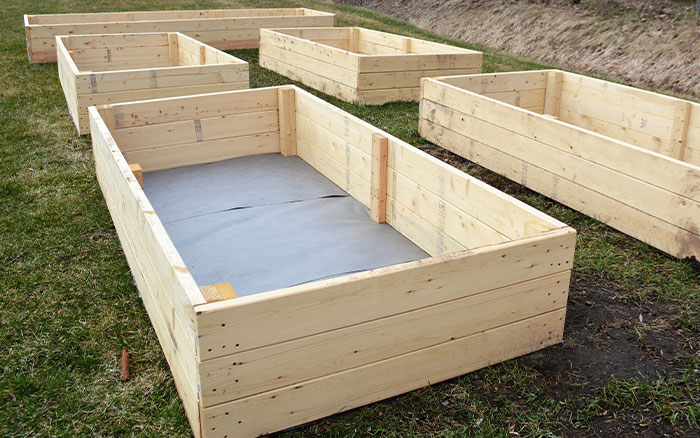Raised beds are a great way of growing in your garden, they allow you to grow a wider range of plants, and boost the drainage in your garden, whilst making gardening more accessible. Here’s how to make raised beds and how to use them.
How to build a raised bed
First, you’ll need to gather the equipment to build:
- Timber (e.g. softwood sleepers)
- Rubber mallet
- Small trowel
- Electric drill
- Spirit level & measuring tape
- Bricks, rubble, and mortar mix

Step one
Prepare the ground by digging out strips of turf for the timber to fit.
Step two
Lay the timber in position to create a square or rectangle, the size you want. Check they are level using the spirit level.
Step three
Measure diagonally as well as the length and ensure the corners are right angles.
Step four
Use the rubber mallet to tap the wood so that the adjacent pieces are level and sturdy.
Step five
Then, drill through the end timbers at the top and bottom. Screw them into position ready for the next level to be added.
Step six
Assemble the next level of timbers and overlap the joints to help with the strength of the structure. Double check with a spirit level before screwing into place.
Step seven
Add rubble or chippings to the bottom of the bed to aid drainage, then fill the bed up with topsoil and compost.
Step eight
Once you’ve done this, you’re good to grow!
Why to use raised beds

Improve drainage
Due to the soil being raised above ground level it allows better drainage which can reduce the risk of waterlogging. However, it can be a disadvantage in times of drought because they may need more water.
Introduce a different soil type to the garden, so you can grow a wider range of plants)
If your garden isn’t the perfect fit to grow the plants that you want, having a raised bed means you can easily add the soil type with what the plants need. For example, you can fill a raised bed with acidic soil for ericaceous plants such as rhododendron, azaleas, and heathers.
Improve access if you have restricted mobility
Raised beds make gardening more accessible for gardeners with mobility issues because they reduce the need for bending lower. By building custom raised beds, they can be built to suit the gardener, whether they are gardening from a stool, wheelchair, or kneeler.
What do I plant in raised beds?
Raised beds can be used to grow almost any plant including fruit, veg, perennials and herbs. They can be used as ornamental beds filled with plants that fit your garden style, or they can be used as productive spaces for growing crops.
A great thing about using raised beds to grow veg is that it allows veg to be sectioned out, which also helps when fertilising and adding organic matter because they are added to a concentrated space.

It also helps with crop rotation as it’s clear to see from separate beds compared to one large veg plot.
The most important thing is to fill your raised beds with fruit and veg that you like to eat. When you pick what you want to grow, be sure to check the amount of space it will need to grow its best so you don’t overcrowd the area which will impact its growth.

Leave A Comment